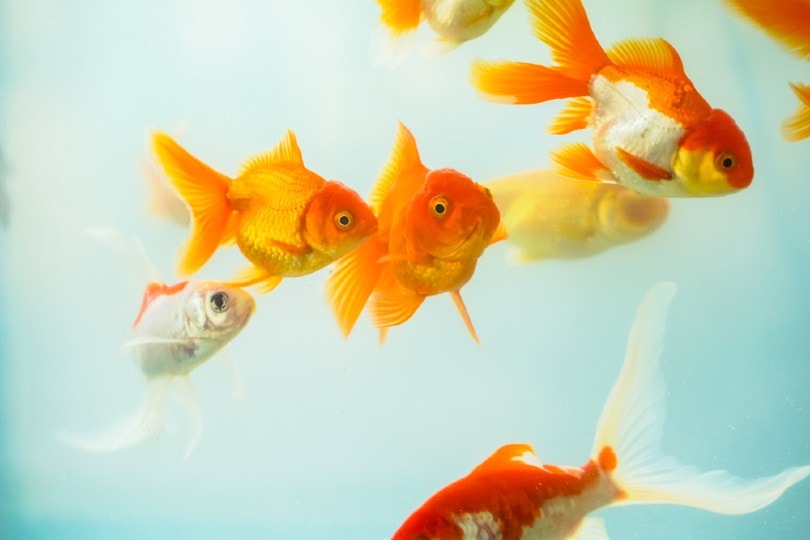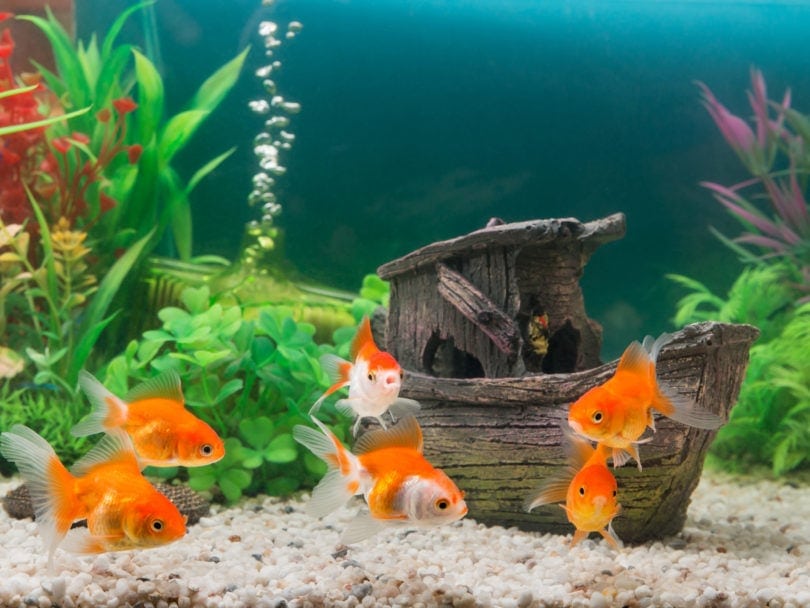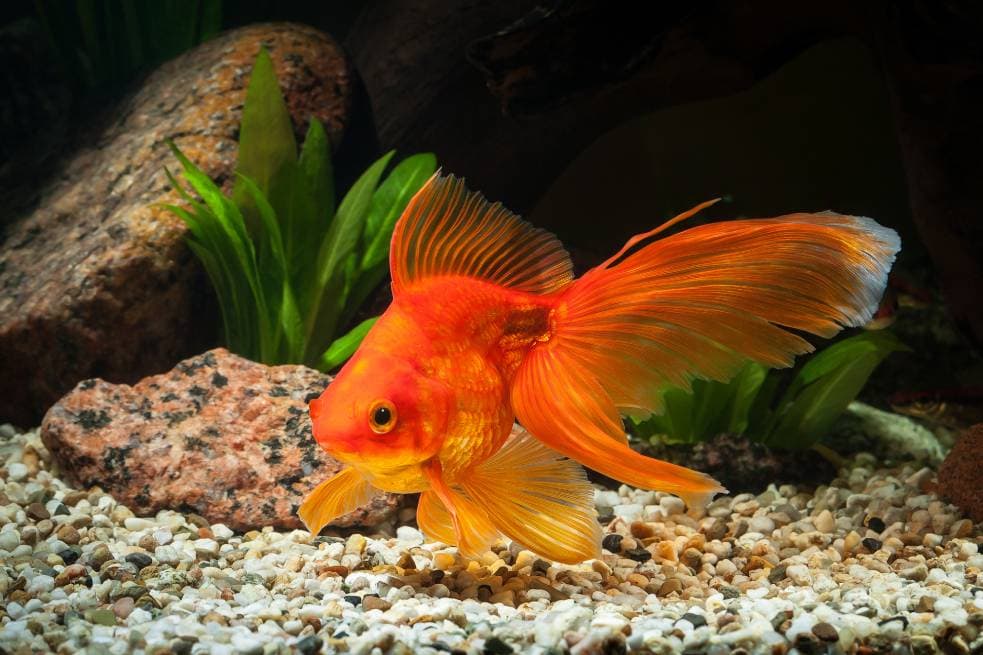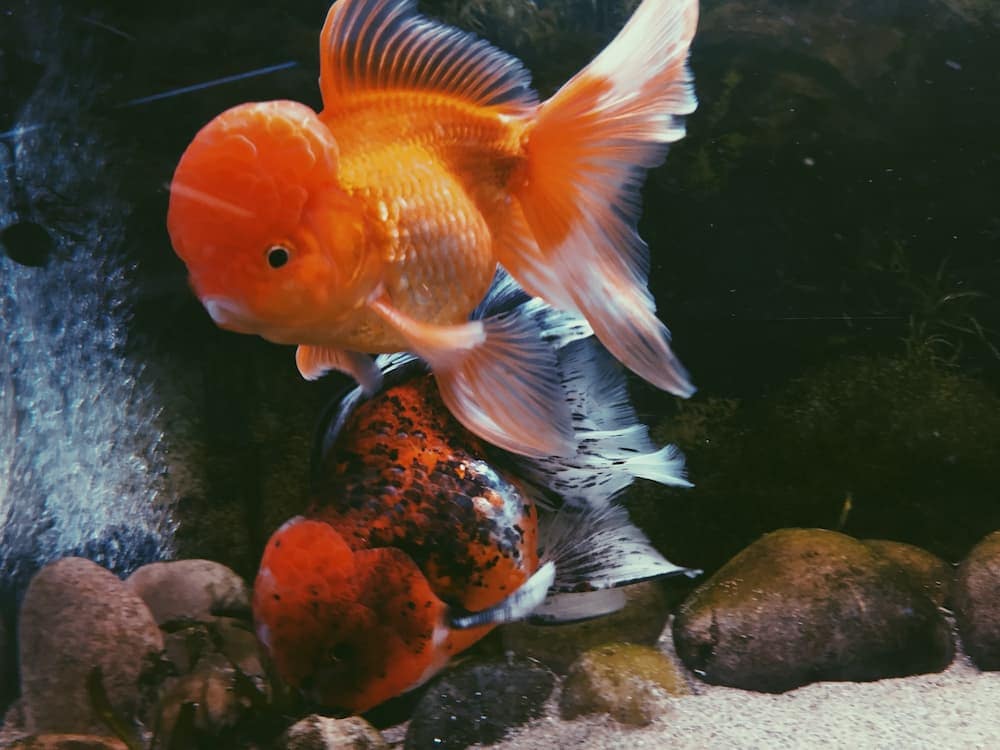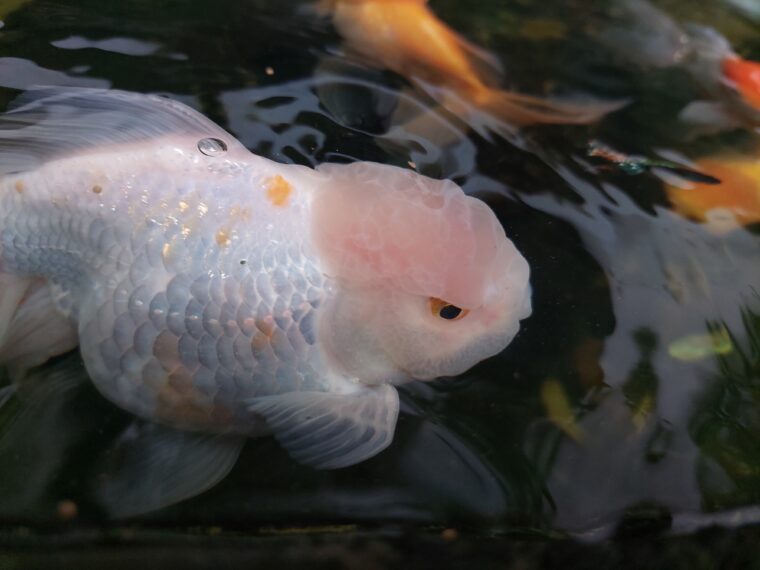
One of the main reasons people like to keep goldfish is that they are relatively inexpensive, are easily obtainable, and come in myriad body types and colors. However, in some cases, a goldfish might be a certain color when purchased, but their owner reports that they have changed colors or started acting weirdly after being kept in a new environment.
In many animals, a behavioral change is often a red flag that something is wrong. A fish that hides all the time or doesn’t eat isn’t feeling well. Another sign that you may see in goldfish is a color change, going from their normal shade to a pale white. Bear in mind that it’s not necessarily a terrible sign. It can also mean something benign (harmless). Let’s look at what would cause a goldfish to turn white.
Normal Colors for Goldfish
Goldfish are part of the Cyprinidae, or Carp, family. In the wild, they are a drab, brownish color that isn’t flashy, to not attract the attention of predators. As in all organisms, mutations happen. For goldfish, the result was the orange and red colors that we commonly associate with these fish. It’s part of the reason that the goldfish made it into the ornamental pools of Chinese royalty.
Goldfish didn’t cross the proverbial pond to the United States until the late 1600s. That ended up playing a significant effect on the spectrum of colors and body features that you can see in these fish today. Black, gold, calico, bronze, red, and white are all possible colors. When discussing a goldfish changing colors, it’s helpful to know what’s affecting what we perceive.

Fish Scales
The color or colors of goldfish are influenced by the types of scales that they have, of which there are three: matte, metallic, and nacreous. Matte ones are just as the name suggests: flat and nothing showy. Metallic ones are a goldfish’s rendition of bling. They’re shiny and can reflect light and thus, color, in different ways. Nacreous scales give varieties like the White Telescope their pearly sheen.
Guanine
Guanine is a chemical compound in DNA. A specialized form exists under the scales of some fish. Because it refracts light, your fish may appear sparkling. Its presence also explains why the scales appear interconnected on the goldfish’s body and not as a group of individual pieces. Think of it as the glue that holds everything together.
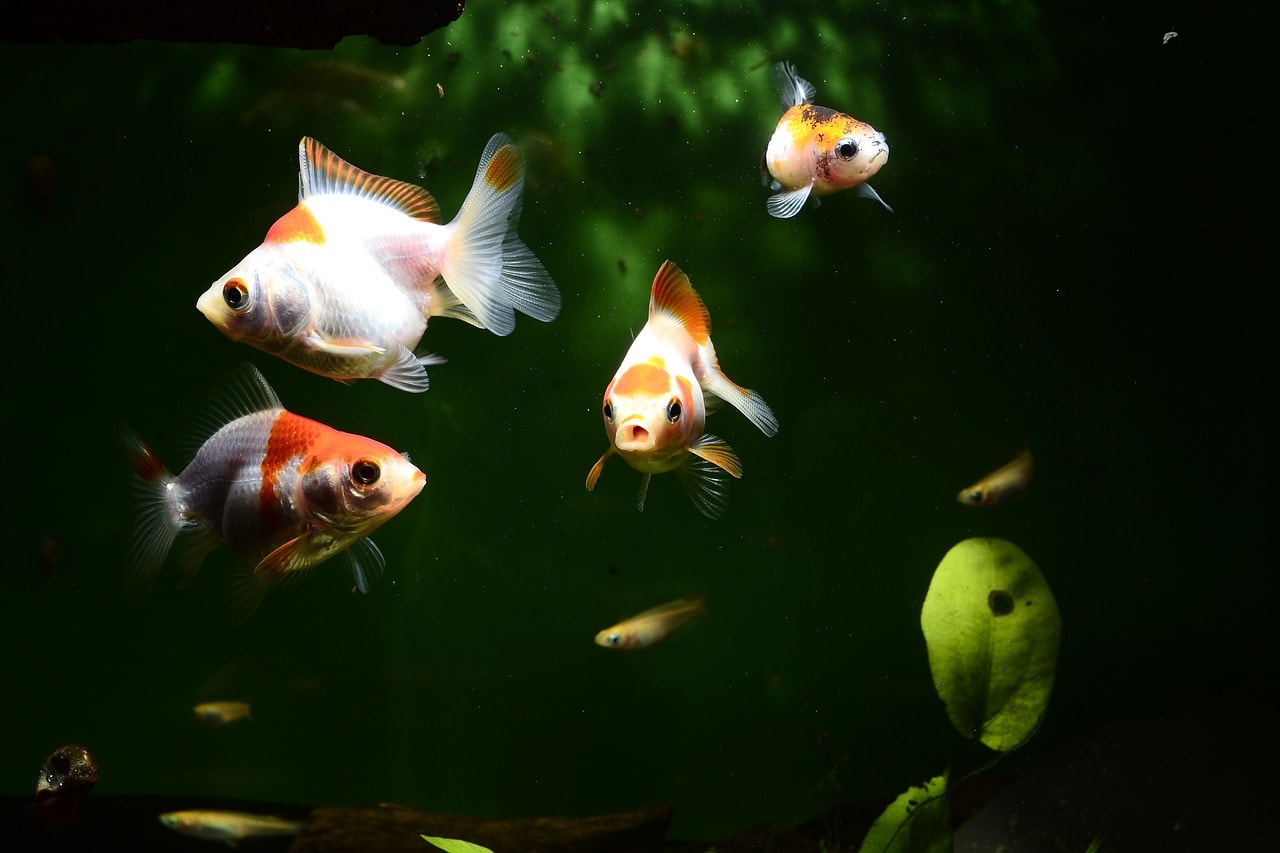
Chromatophores
The scales and guanine are the supporting cast of what ultimately determines the color of your goldfish: its chromatophores. These are cells that give color to various structures, including the eyes and scales. The distribution of the different types is part of a fish’s genetics.
Some animals, such as chameleons, can change color quickly in response to stimuli in the environment. Goldfish aren’t a part of that group. That’s why a fish turning white is unusual, especially if it happens rapidly. That’s not to say that it can’t occur, though. The goldfish’s ability is just a limited form of camouflage.
The 7 Reasons Your Goldfish Is Turning White:
1. Genetics
Genetics comes into play as a goldfish matures. Remember that goldfish are domesticated animals that have been selectively bred for hundreds of years. If your fish is gradually turning white, it may be its DNA coming to the forefront. There is not a guarantee that your fish won’t change color as it matures. It isn’t a cause for concern because there’s nothing you can do about it.
2. Illness or Parasite Infestation
On the other hand, certain things are worth investigating. Disease and parasite infections can cause color changes, such as goldfish Ich. Fungal conditions can also be a culprit. We suggest monitoring your fish for other signs, such as clamped fins, flashing, appetite changes, and lethargy. That could identify a cause and thus, lead to a treatment.
Related Read: Goldfish Lice & Anchor Worm
3. Dietary Effects
Many animals change color based on the foods they eat. Flamingoes are a classic example. The vibrant salmon pink color that we associate with them comes from the beta-carotene content of the crustaceans they eat. If zookeepers didn’t offer these foods to them, the birds would be white instead of their usual hue. The same is true with goldfish. That’s why you see products marketed as being color-enhancing.
Many goldfish die as a result of improper feeding, diet, and/or portion sizes – which can be easily prevented by proper education. That's why we recommend the best-selling book, The Truth About Goldfish, which covers everything about goldfish nutrition, tank maintenance, illnesses & more! Check it out on Amazon today.
4. Stress
Stress is often a trigger for pigment changes that may provide better camouflage to protect vulnerable fish. Several things can cause it, from moving to a new tank to changing water conditions. Bear in mind that these animals inherited a keen awareness of their surroundings from evolution. It helped ensure their survival. Your goldfish’s instinct is to respond cautiously to new things in its world.
5. Old Age
Goldfish aren’t unlike many animals that turn lighter as they age. They can live 15-20 or more years with proper care. In the meantime, they can show where they are on life’s journey by turning white as they get older. It typically comes on gradually and without any other noticeable signs. Of course, there’s not much you can do to stop time from moving forward.

6. Lack of UV Light
Goldfish need UV light for their chromatophores to produce pigment. That’s why it’s essential to provide it via a lamp or hood. Otherwise, their colors will lose their luster over time, becoming duller and paler. This is also why fish transported in dark conditions tend to turn pale over the course of their journey. This phenomenon goes back to the fish’s genetics. Remember that in the wild, they would be swimming in bodies of water where there would be ample sunlight.
7. Low Oxygen Levels
Good water quality is of profound importance to fish, particularly dissolved oxygen. For your goldfish to thrive, the oxygen level must be at 5-6 ppm (ppm). Low levels of oxygen, particularly lower than 3 ppm, will likely lead to stress or mortalities. That’s why it’s imperative to monitor your tank’s water chemistry. Weekly testing will go a long way toward providing a healthy environment for your goldfish.
The hallmark of low oxygen in a tank is the goldfish trying to stay near the water’s surface all the time, rather than moving around the tank. Oxygen is highly concentrated at the surface and enters the water (while carbon dioxide escapes) when its surface is agitated. This is the principle of how water aerators work (the bubbles that they produce are purely cosmetic, though, as they aerate the water by agitating the water surface). Aerators also increase the water’s surface area when they agitate it at the surface.
Bowls are considered to be bad for goldfish because they have a narrow neck, so the surface area at the top of the bowl is quite small, and the amount of oxygen that a bowl can hold versus a square or rectangular tank of the same volume is lower.
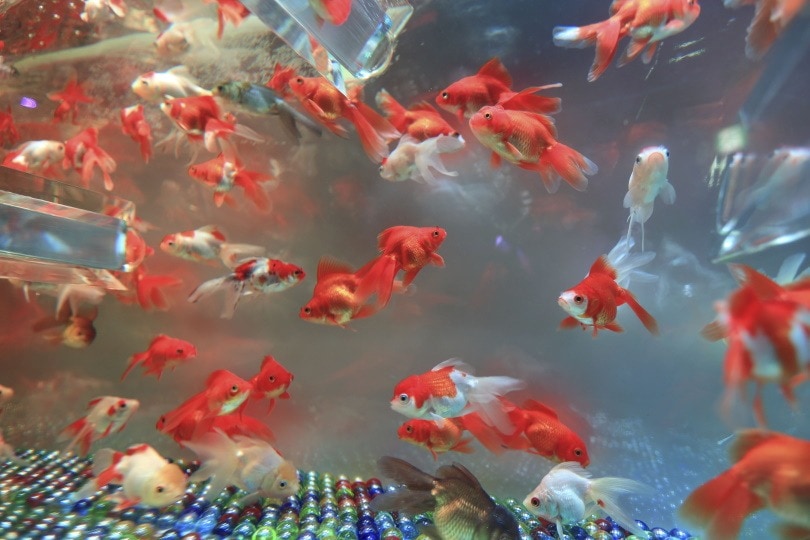
Treatment Options
Your choice of treatment depends on what’s causing your goldfish to turn white. Many causes are beyond your control and not a cause for concern. Illnesses and water quality issues demand prompt action. You can find commercial products to treat diseases and parasites. It’s essential to use a product for a specific condition, whether bacterial, fungal, or parasitic.
That said, no medication intended to treat ailments in goldfish will work if their water quality is subpar. The main priority when treating goldfish is to address any water quality issues before doing anything else (such as adding medication into their tank).
In addition, activated carbon in a tank’s filter will neutralize most chemicals added to the tank (including medication). These need to be removed before treating the tank.
We recommend using medications specifically formulated for use with goldfish or koi. Follow the directions exactly, particularly the dose based on the volume of your aquarium. It is best to confirm a diagnosis with an agricultural department fish expert or your aquatic veterinarian before attempting treatment. You should also consider temporarily removing live plants that may get harmed by these products.
Creating a stress-free environment with the correct setup will help keep stress under control. Adding a UV light and providing a color-enhancing food will soon get your goldfish looking their best again. Bear in mind that these are lifestyle changes. If you stop any of them, your fish will likely start turning white again.
Final Thoughts
Goldfish are popular pet fish that are mainstays for aquatic enthusiasts and newcomers alike. Color changes can denote either time, genetics, or a cause for concern. Observation will provide the answer to how you should respond. As long as no other signs are present, you can make dietary and tank adjustments and hope for the best.
Featured Image Credit: Andrii Oleksiienko, Shutterstock





